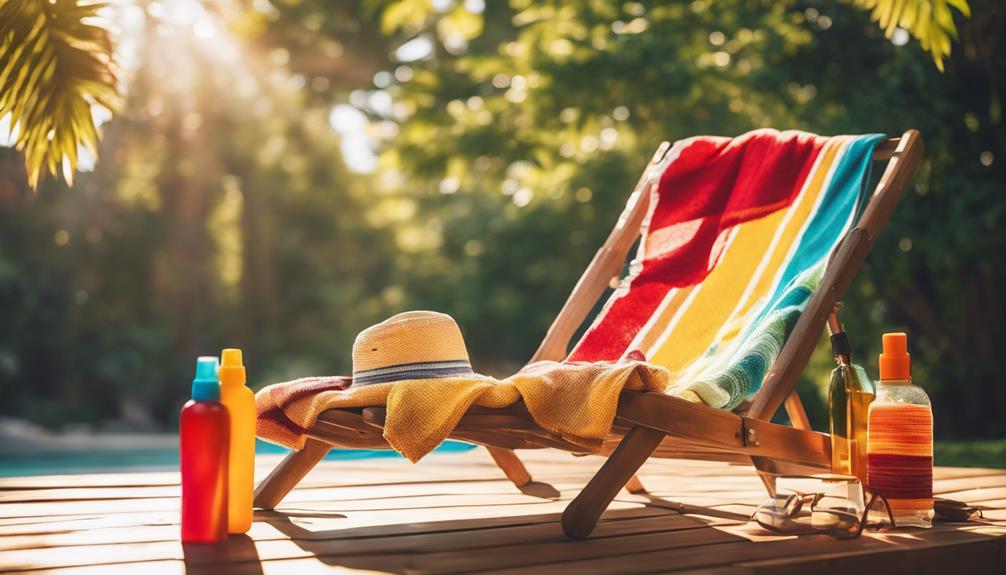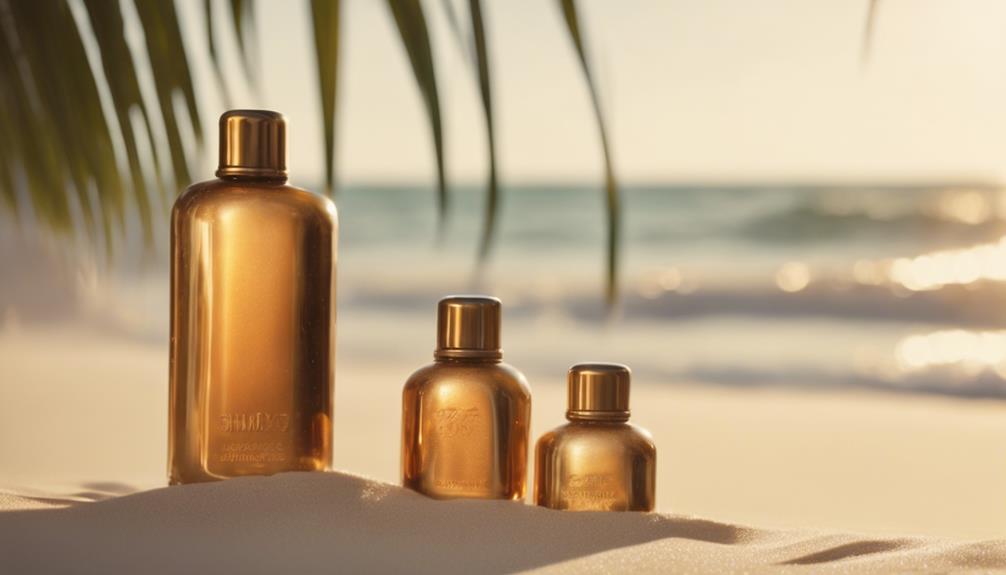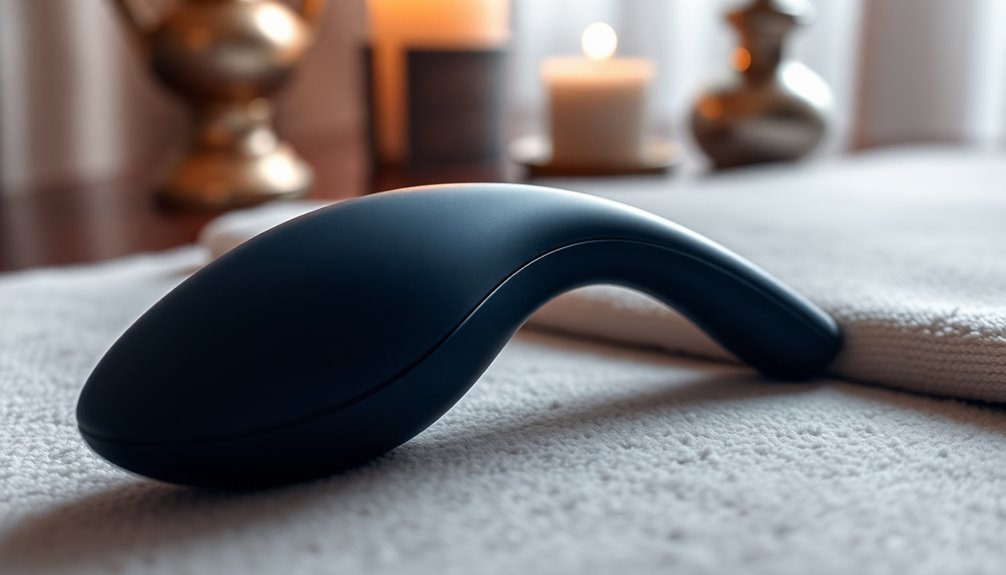Understanding UV exposure times is essential for safe indoor tanning. Your skin type, based on the Fitzpatrick scale, determines how long you should tan. If you have very fair skin (Type I), limit sessions to 5-10 minutes, while darker skin types (V and VI) can safely tan for 30-45 minutes. Always wear protective eyewear and apply sunscreen with at least SPF 30 to avoid damage. Gradually increase your tanning duration and monitor your skin for any reactions. You can optimize your tanning routine and keep your skin healthy with the right techniques, so let's explore more effective practices.
Key Takeaways
- The Fitzpatrick scale categorizes skin types, influencing recommended tanning times to minimize skin damage and maximize results.
- Indoor tanning times vary: Type I should limit sessions to 5-10 minutes, while Types V and VI can safely tan for 30-45 minutes.
- Always wear protective eyewear and apply broad-spectrum sunscreen with at least SPF 30 before tanning sessions.
- Monitor skin for signs of overexposure, such as redness or itching, and adjust tanning duration accordingly.
- Incorporate rest days to allow skin recovery and prevent peeling, enhancing overall tanning results.
Importance of Tanning Time Awareness

Recognizing the importance of tanning time awareness can greatly impact your skin health and tanning results. Understanding your skin type, as categorized by the Fitzpatrick scale, is essential because it directly influences your recommended exposure times.
For instance, those with fair skin might need to limit initial sessions to just 5-15 minutes, while darker skin types can handle longer durations. Gradually increasing tanning durations allows your skin to build melanin safely, minimizing the risk of skin damage and enhancing your tanning results.
It's important to continuously assess your skin sensitivity and tanning response to create personalized tanning schedules. Properly identifying your skin type not only boosts your confidence in the tanning process but also guarantees safety.
Individual reactions to UV exposure can vary widely, so staying attentive to your skin's needs helps prevent overexposure and sunburn. Following FDA guidelines for exposure times is significant, especially in salons, as they monitor radiation doses and protect you from acute injury and long-term skin damage.
Fitzpatrick Skin Type Overview
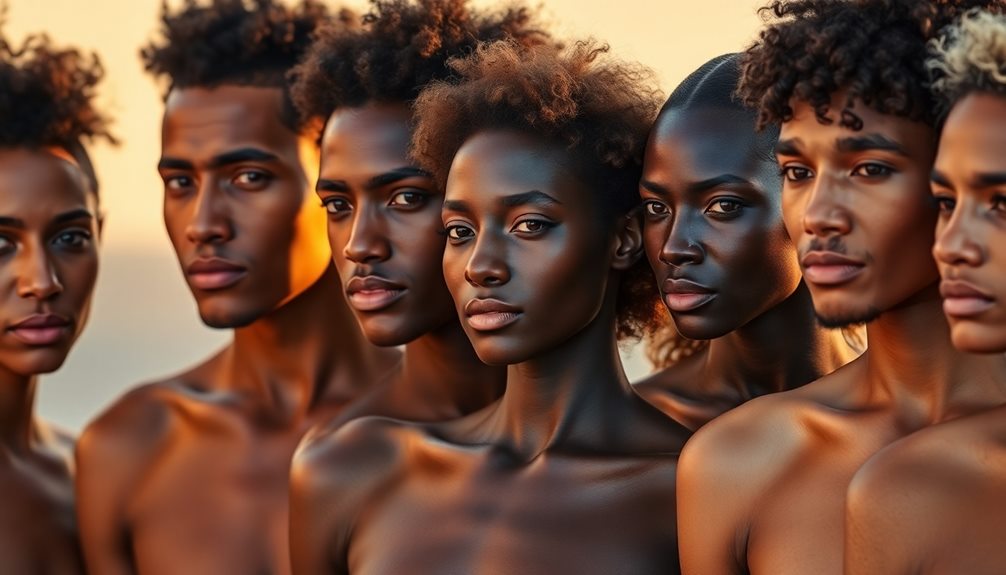
Understanding your skin type is essential for safe tanning practices, and the Fitzpatrick scale provides a clear framework for categorizing skin based on melanin levels and UV response. This scale ranges from Type I, which is very fair and always burns, to Type VI, which is very dark and rarely burns.
If you have Type I skin, it's best to avoid UV exposure altogether, while Type II skin burns severely and has minimal tanning potential.
For those with Type III skin, characterized by light brown tones, you may experience some burning but can achieve a uniform tan with moderate exposure to UV radiation.
Types IV to VI possess light to moderate brown tones, allowing for a higher tolerance to UV exposure and easier tanning. However, even if you tan easily, don't forget the risk of skin damage and skin cancer.
Accurate skin typing is vital for determining safe tanning durations and minimizing overexposure during indoor tanning sessions. By understanding your Fitzpatrick skin type, you can make informed decisions that protect your skin while enjoying the benefits of tanning.
Recommended Tanning Times by Skin Type

Knowing your Fitzpatrick skin type helps tailor your tanning routine to minimize risks and maximize results.
For those with Fitzpatrick Skin Type I, characterized by pale skin that always burns, limit your tanning sessions to 5-10 minutes, but only after establishing a base tan.
If you're a Type II, which usually burns and has minimal tanning ability, start with 10-15 minutes and gradually increase to 20-25 minutes.
Type III, who sometimes burns and tans uniformly, can begin with 15-20 minutes, eventually working up to 30-35 minutes.
If you have Fitzpatrick Skin Type IV, with light brown skin that rarely burns, you can safely tan for 20-30 minutes per session.
For Types V and VI, which include moderate to dark brown skin that very rarely burns, the recommended tanning times are 30-45 minutes.
Regardless of your skin type, always remember that sunscreen application is essential to protect your skin health.
As you tan, be mindful of your skin sensitivity and tan gradually, allowing your skin to adjust over time.
This approach will help you achieve a beautiful, bronzed look while minimizing risks associated with UV exposure.
Safety Precautions for Indoor Tanning
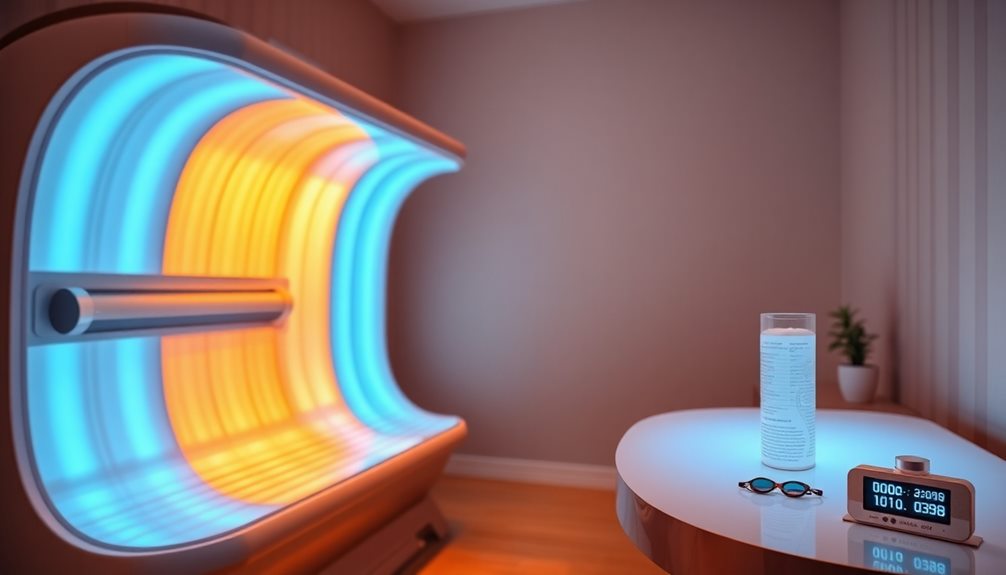
When you choose to indoor tan, it's important to prioritize safety to protect your skin from harmful UV exposure.
Start by using protective eyewear, like goggles, to shield your eyes from harmful UV radiation during your sessions. Always apply a broad-spectrum sunscreen with at least SPF 30 to any exposed skin before stepping into a tanning bed; this can help safeguard against UV rays, even indoors. Additionally, limit the duration of your tanning sessions to reduce overexposure and minimize the risk of skin damage. After each session, ensure proper hygiene by selecting facilities that prioritize ecofriendly tanning bed cleaning, which not only maintains cleanliness but also supports environmentally conscious practices. Remember to stay hydrated and moisturize your skin afterward to retain its natural elasticity and glow.
Gradually increase your tanning times based on your skin type to prevent overexposure. For instance, if you have Fitzpatrick Skin Type I, begin with just 5-10 minutes.
It's imperative to monitor your skin for signs of overexposure, such as redness or itching. If you notice these symptoms, take a break and allow your skin to recover between sessions.
Hydration is significant too; drink plenty of water and moisturize your skin post-tanning to maintain skin health and enhance your tan's longevity.
Best Practices for Skin Care
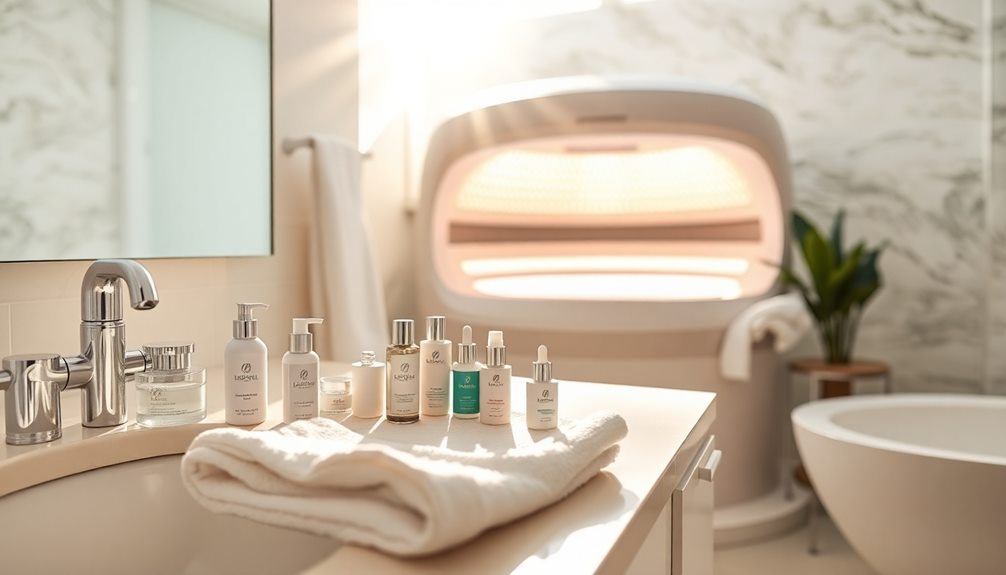
Before you start tanning, it's essential to prepare your skin properly to guarantee an even and safe tan. This includes using moisturizers and hydrating serums to lock in moisture, as well as limiting exposure to harsh environmental factors.
After tanning, focus on hydrating your skin with the right products to maintain its health and glow. To enhance your results, consider incorporating regular skin treatments, which can greatly boost skin health and appearance regular skin treatments.
Pre-Tanning Skin Preparation
Preparing your skin properly can make a significant difference in achieving a beautiful, even tan. Start by ensuring your skin is clean before tanning. Remove any lotions, oils, or makeup to allow for ideal absorption of UV rays and an even tanning experience.
Exfoliate your skin 24 hours prior to your session to get rid of dead skin cells, which can lead to uneven results and patchiness.
Before you step into the tanning booth, apply a broad-spectrum sunscreen with at least SPF 30 on any exposed areas. Even during indoor tanning, protecting your skin from harmful UV exposure is essential.
Next, consider using a specialized indoor tanning lotion designed to enhance hydration and promote a deeper, longer-lasting tan without clogging your pores.
Lastly, don't forget about hydration! Drink plenty of water before your tanning session to support skin health and reduce the risk of dehydration from UV exposure.
Post-Tanning Hydration Routine
Your skin's health post-tanning is just as important as the preparation before a session. After your tanning sessions, prioritize post-tanning hydration to replenish moisture and soothe your skin.
Apply a moisturizer specifically designed for after-sun care immediately to help calm any irritation.
Don't forget to drink plenty of water—aim for 8-10 glasses daily, increasing your intake during tanning sessions to support overall skin hydration. This is vital for maintaining skin health.
Additionally, using broad-spectrum sunscreen with at least SPF 30 on exposed areas after tanning will help protect against further UV damage.
Incorporating aloe vera or hydrating serums into your routine can also provide relief from inflammation and enhance moisture retention.
To prolong the life of your tan and keep your skin soft, use a moisturizing lotion or cream regularly. This not only prevents dryness and peeling but also keeps your skin looking radiant.
Monitoring Skin Health During Tanning

Monitoring skin health during tanning is essential for preventing long-term damage and ensuring a safe experience. Regular skin checks for new or changing moles are vital; if you notice any unusual spots, consult a dermatologist immediately.
During tanning sessions, keep an eye out for skin reactions like redness, itching, or blistering. These signs indicate overexposure and signal the need for a break to allow for proper skin recovery.
Hydration plays a significant role in maintaining skin health. Aim to drink 8-10 glasses of water daily to support your skin during and after UV exposure. After tanning, apply moisturizers specifically designed for after-sun care. This helps keep your skin hydrated and minimizes the risk of peeling or dryness.
Additionally, don't underestimate the importance of rest days between tanning sessions. Giving your skin time to recover reduces the risk of long-term damage and allows it to heal.
Frequently Asked Questions
What Is the Exposure Schedule on a Tanning Unit?
The exposure schedule on a tanning unit depends on the lamp output and your skin type. You'll want to start with shorter sessions, gradually increasing time while spacing them out to avoid skin damage.
What Is the Best UV Level for Tanning?
While basking under a gentle sun feels inviting, the best UV level for tanning lies between 3 and 6. This balance lets you achieve a beautiful glow without risking painful burns or long-term skin damage.
What Is the Best Indoor Tanning Schedule?
To create the best indoor tanning schedule, start with 2-3 sessions in your first week, each lasting 3-10 minutes. Gradually increase frequency and duration while monitoring your skin's reaction for safety.
How Fast Do You Tan in UV 7?
At a UV index of 7, you'll likely start to notice tanning effects after 10-30 minutes, depending on your skin type. Always monitor your skin's response and limit exposure to prevent burns.
Conclusion
In understanding UV exposure times, you're not just ensuring a golden glow; you're prioritizing your skin's health. The theory that "a little sun is good for you" can lead to dangerous overexposure. By recognizing your Fitzpatrick skin type and adhering to recommended tanning times, you can enjoy the benefits of indoor tanning while minimizing risks. Remember, it's not just about aesthetics; it's about protecting your skin for the long term. Choose wisely and care for your skin!


